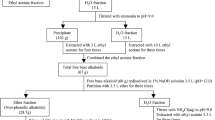Abstract
Secondary metabolites of tropical seaweed are proven to exhibit variety of biological activities. Six species of seaweed (Caulerpa racemosa var. laete-virens, Caulerpa sertularioides f. longipes, Halymenia dilatata, Laurencia snackeyi, Padina boryana, and Sargassum swartzii) were tested for anti-inflammatory activity in lipopolysaccharide (LPS)-stimulated RAW 264.7 cells. Crude L. snackeyi extract exhibit potent activity, and upon bioassay-guided isolation, it contained four halogenated compounds that exert profound inhibitory effects against nitric oxide (NO) production in LPS-stimulated RAW 264.7 cells. These compounds were subjected to spectroscopic measurements and were identified as palisadin A (1), aplysistatin (2), 5-acetoxypalisadin B (3), and palisol (4). Further experiments showed aplysistatin (2) to significantly inhibit NO production and prostaglandin-E2 (PGE2) production, and suppress inducible nitric oxide synthase (iNOS) and cyclooxygenase-2 (COX-2) expression in LPS-stimulated RAW 264.7 cells. Therefore, aplysistatin (2) is suggested to inhibit NO and PGE2 production via the inhibition of iNOS and COX-2, indicating that its activity may be attributed to the modulation of anti-inflammatory agents.






Similar content being viewed by others
References
Anjaneyulu ASR, Prakash CVS, Mallavadhani UV (1991) Two caulerpin analogues and a sesquiterpene from Caulerpa racemosa. Phytochem 30:3041–3042
Bitencourt MAO, Dantas GR, Lira DP, Barbosa-Filho JM, Miranda GEC, Santos BVO, Souto JT (2009) Aqueous and methanolic extracts of Caulerpa mexicana suppress cell migration and ear edema induced by inflammatory agents. Mar Drugs 9:1332–1345
Capon RJ, Ghisalberti EL, Jefferies PR (1983) Metabolites of the green algae, Caulerpa species. Phytochem 22:1465–1467
Cho JY, Baik KU, Jung JH, Park MH (2000) In vitro anti-inflammatory effects of cynaropicrin, a sesquiterpene lactone, from Saussurea lappa. Eur J Pharmacol 398:399–407
Graça JRV, Bezerra MM, Lima V, Rodrigues JAG, Monteiro DLS, Quindere ALG, Amorim RCN, Paula RCM, Benevides NMB (2011) Effect of a crude sulfated polysaccharide from Halymenia floresia (Rhodophyta) on gastrointestinal smooth muscle contractility. Braz Arch Biol Technol 54:907–916
Gul W, Hamann MT (2005) Indole alkaloid marine natural products: an established source of cancer drug leads with considerable promise for the control of parasitic, neurological and other diseases. Life Sci 78:442–453
Kamada T, Vairappan CS (2012) A new bromoallene-producing chemical type of the red alga Laurencia nangii Masuda. Molecules 17:2119–2125
Kazlowska K, Hsu T, Hou CC, Yang WC, Tsai GJ (2010) Anti-inflammatory properties of phenolic compounds and crude extract from Porphyra dentate. J Ethanopharmacol 128:123–130
Kintzios S, Papageorgiou K, Yiakoumettis I, Baricevic D, Kusar A (2010) Evaluation of the antioxidants activities of four solvene medicinal plant species by traditional and novel biosensory assays. J Pharm Biomed Anal 53:773–776
Kim JK, Oh SM, Kwon HS, Oh YS, Lim SS, Shin HK (2006) Anti-inflammatory effect of roasted licorice extracts on liposaccharide-induced inflammatory responses in murine macrophages. Biochem Biophys Res Commun 345:1215–1223
Kuniyoshi M, Marma MS, Higa T, Bernardinelli G, Jefford CW (2001) New bromoterpenes from the red alga Laurencia luzonensis. J Nat Prod 64:696–700
Lai MF, Li CF, Li CY (1994) Characterization and thermal behavior of six sulphated polysaccharides from seaweeds. Food Hydrocoll 8:215–232
Lee M, Lee JM, Jun SH, Lee SH, Kim NW, Lee JH, Ko NY, Mun SH, Kim BK, Lim BO, Choi DK, Choi WS (2007) The anti-inflammatory effects of Pyrolae herba extract through the inhibition of the expression of inducible nitric oxide synthase (iNOS) and NO production. J Ethnopharmacol 112:49–54
Li YX, Li Y, Qian ZJ, Kim MM, Kim SK (2009) In vitro antioxidant activity of 5-HMF isolated from marine red alga Laurencia undulata in free radical mediated oxidative systems. J Microbiol Biotechnol 19:1319–1327
Mohamed S, Hashim SN, Rahman HA (2012) Seaweeds: a sustainable functional food for complementary and alternative therapy. Trends Food Sci Technol 23:83–96
Park EJ, Jhon DY (2010) The antioxidant, angiotensin converting enzyme inhibition activity, and phenolic compounds of bamboo shoot extracts. LWT-Food Sci Technol 43:655–659
Paul V, Fenical W (1980) Palisadins A, B and related monocyclofarnesol-derived sesquiterpenoids from the red marine alga Laurencia cf. palisade. Tet Lett 21:2787–2790
Paul V, Fenical W (1985) Diterpenoid metabolites from pacific marine algae of the order Caulerpales (Chlorophyta) (1985). Phytochemistry 24:2239–2243
Souza ET, Lira DP, Queiroz AC, Silva DJC, Aquino AB, Mella EAC, Lorenzo VP, Miranda GEC, Araújo-Júnior JX, Chaves MCO, Barbosa-Filho JM, Athayde-Filho PF, Santos BVO, Alexandre-Moreira MS (2009) The antinociceptive and anti-inflammatory activities of caulerpin, a bisindole alkaloid isolated from seaweeds of the genus Caulerpa. Mar Drugs 7:689–704
Suzuki M, Vairappan CS (2005) Halogenated secondary metabolites from Japanese species of the red algal genus Laurencia (Rhodomelaceae, Ceramiales). Curr Topics Phytochem 7:1–38
Tan KL, Matsunaga S, Vairappan CS (2011) Halogenated chamigranes of red alga Laurencia snackeyi (Weber-van Bosse) Masuda from Sulu-Sulawesi sea. Biochem Syst Ecol 39:213–215
Vairappan CS (2003) Potent antibacterial activity of halogenated metabolites from Malaysian red algae, Laurencia majuscula (Rhodomelaceae, Ceramiales). Biomol Eng 20:255–259
Vairappan CS, Tan KL (2005) Halogenated secondary metabolites from sea hare Aplysia dactylomela. Malays J Sci 24:17–22
Vairappan CS, Suzuki M, Ishii T, Okino T, Abe T, Masuda M (2008) Antibacterial activity of halogenated sesquiterpenes from Malaysian Laurencia spp. Phytochemistry 69:2490–2494
Wijesinghe WAJP, Jeon YJ (2012) Enzyme-assistant extraction of bioactive components: a useful approach for recovery of industrially important metabolites from seaweeds. Fitoterapia 83:6–12
Acknowledgments
CSV would like to express his appreciation to KORDI for partially funding this project. Permit to collect the seaweeds was obtained by CSV from Sabah Parks, Malaysia, and it is highly appreciated.
Author information
Authors and Affiliations
Corresponding authors
Rights and permissions
About this article
Cite this article
Vairappan, C.S., Kamada, T., Lee, WW. et al. Anti-inflammatory activity of halogenated secondary metabolites of Laurencia snackeyi (Weber-van Bosse) Masuda in LPS-stimulated RAW 264.7 macrophages. J Appl Phycol 25, 1805–1813 (2013). https://doi.org/10.1007/s10811-013-0023-6
Received:
Revised:
Accepted:
Published:
Issue Date:
DOI: https://doi.org/10.1007/s10811-013-0023-6




